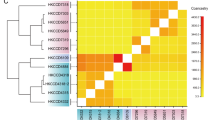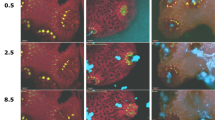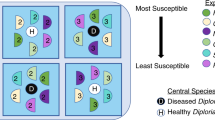Abstract
Increasing evidence confirms the crucial role bacteria and archaea play within the coral holobiont, that is, the coral host and its associated microbial community. The bacterial component constitutes a community of high diversity, which appears to change in structure in response to disease events. In this study, we highlight the limitation of 16S rRNA gene (16S rDNA) clone library sequencing as the sole method to comprehensively describe coral-associated communities. This limitation was addressed by combining a high-density 16S rRNA gene microarray with, clone library sequencing as a novel approach to study bacterial communities in healthy versus diseased corals. We determined an increase in diversity as well as a significant shift in community structure in Montastraea faveolata colonies displaying phenotypic signs of White Plague Disease type II (WPD-II). An accumulation of species that belong to families that include known coral pathogens (Alteromonadaceae, Vibrionaceae), bacteria previously isolated from diseased, stressed or injured marine invertebrates (for example, Rhodobacteraceae), and other species (for example, Campylobacteraceae) was observed. Some of these species were also present in healthy tissue samples, but the putative primary pathogen, Aurantimonas corallicida, was not detected in any sample by either method. Although an ecological succession of bacteria during disease progression after causation by a primary agent represents a possible explanation for our observations, we also discuss the possibility that a disease of yet to be determined etiology may have affected M. faveolata colonies and resulted in (or be a result of) an increase in opportunistic pathogens.
Similar content being viewed by others
Log in or create a free account to read this content
Gain free access to this article, as well as selected content from this journal and more on nature.com
or
Accession codes
References
Amaro C, Biosca EG . (1996). Vibrio vulnificus biotype 2, pathogenic for eels, is also an opportunistic pathogen for humans. Appl Environ Microbiol 62: 1454–1457.
Baker AC . (2003). Flexibility and specificity in coral-algal symbiosis: diversity, ecology, and biogeography of Symbiodinium. Annual Review of Ecology, Evolution, and Systematics 34: 661–689.
Barneah O, Ben-Dov E, Kramarsky-Winter E, Kushmaro A . (2007). Characterization of black band disease in Red Sea stony corals. Environ Microbiol 9: 1995–2006.
Baron S . (1996). Medical Microbiology, 4th edn, The University of Texas Medical Branch at Galveston: Galveston, TX, USA.
Ben-Haim Y, Rosenberg E . (2002). A novel Vibrio sp. pathogen of the coral Pocillopora damicomis. Mar Biol 141: 47–55.
Bentis CJ, Kaufman L, Golubic S . (2000). Endolithic fungi in reef-building corals (Order: Scleractinia) are common, cosmopolitan, and potentially pathogenic. Biol Bull 198: 254–260.
Bourne D, Iida Y, Uthicke S, Smith-Keune C . (2008). Changes in coral-associated microbial communities during a bleaching event. ISME J 2: 350–363.
Bourne DG, Munn CB . (2005). Diversity of bacteria associated with the coral Pocillopora damicornis from the Great Barrier Reef. Environ Microbiol 7: 1162–1174.
Brodie EL, Desantis TZ, Joyner DC, Baek SM, Larsen JT, Andersen GL et al. (2006). Application of a high-density oligonucleotide microarray approach to study bacterial population dynamics during uranium reduction and reoxidation. Appl Environ Microbiol 72: 6288–6298.
Brodie EL, DeSantis TZ, Parker JP, Zubietta IX, Piceno YM, Andersen GL . (2007). Urban aerosols harbor diverse and dynamic bacterial populations. Proc Natl Acad Sci USA 104: 299–304.
Cervino JM, Hayes RL, Polson SW, Polson SC, Goreau TJ, Martinez RJ et al. (2004). Relationship of Vibrio species infection and elevated temperatures to yellow blotch/band disease in Caribbean corals. Appl Environ Microbiol 70: 6855–6864.
Chao A . (1984). Nonparametric estimation of the number of classes in a population. Scand J Statist 11: 265–270.
Chao A, Lee SM . (1992). Estimating the number of classes via sample coverage. J Am Stat Assoc 87: 210–217.
Cole JR, Chai B, Farris RJ, Wang Q, Kulam-Syed-Mohideen AS, McGarrell DM et al. (2007). The ribosomal database project (RDP-II): introducing myRDP space and quality controlled public data. Nucleic Acids Res 35: D169–D172.
Cooney RP, Pantos O, Le Tissier MD, Barer MR, O'Donnell AG, Bythell JC . (2002). Characterization of the bacterial consortium associated with black band disease in coral using molecular microbiological techniques. Environ Microbiol 4: 401–413.
Denner EBM, Smith GW, Busse HJ, Schumann P, Narzt T, Polson SW et al. (2003). Aurantimonas coralicida gen. nov., sp nov., the causative agent of white plague type II on Caribbean scleractinian corals. Int J Syst Evol Microbiol 53: 1115–1122.
DeSalvo MK, Voolstra CR, Sunagawa S, Schwarz JA, Stillman JH, Coffroth MA et al. (2008). Differential gene expression during thermal stress and bleaching in the Caribbean coral Montastraea faveolata. Mol Ecol 17: 3952–3971.
DeSantis TZ, Brodie EL, Moberg JP, Zubieta IX, Piceno YM, Andersen GL . (2007). High-density universal 16S rRNA microarray analysis reveals broader diversity than typical clone library when sampling the environment. Microb Ecol 53: 371–383.
DeSantis TZ, Hugenholtz P, Keller K, Brodie EL, Larsen N, Piceno YM et al. (2006a). NAST: a multiple sequence alignment server for comparative analysis of 16S rRNA genes. Nucleic Acids Res 34: W394–W399.
DeSantis TZ, Hugenholtz P, Larsen N, Rojas M, Brodie EL, Keller K et al. (2006b). Greengenes, a chimera-checked 16S rRNA gene database and workbench compatible with ARB. Appl Environ Microbiol 72: 5069–5072.
Downs CA, Fauth JE, Robinson CE, Curry R, Lanzendorf B, Halas JC et al. (2005). Cellular diagnostics and coral health: declining coral health in the Florida Keys. Mar Pollut Bull 51: 558–569.
Dunbar J, Barns SM, Ticknor LO, Kuske CR . (2002). Empirical and theoretical bacterial diversity in four Arizona soils. Appl Environ Microbiol 68: 3035–3045.
Ewing B, Green P . (1998). Base-calling of automated sequencer traces using phred. II. Error probabilities. Genome Res 8: 186–194.
Ewing B, Hillier L, Wendl MC, Green P . (1998). Base-calling of automated sequencer traces using phred. I. Accuracy assessment. Genome Res 8: 175–185.
Frias-Lopez J, Zerkle AL, Bonheyo GT, Fouke BW . (2002). Partitioning of bacterial communities between seawater and healthy, black band diseased, and dead coral surfaces. Appl Environ Microbiol 68: 2214–2228.
Gentry TJ, Wickham GS, Schadt CW, He Z, Zhou J . (2006). Microarray applications in microbial ecology research. Microb Ecol 52: 159–175.
Gil-Agudelo DL, Fonseca DP, Weil E, Garzon-Ferreira J, Smith GW . (2007). Bacterial communities associated with the mucopolysaccharide layers of three coral species affected and unaffected with dark spots disease. Can J Microbiol 53: 465–471.
Gil-Agudelo DL, Smith GW, Weil E . (2006). The white band disease type II pathogen in Puerto Rico. Rev Biol Trop 54: 59–67.
Gonzalez SF, Krug MJ, Nielsen ME, Santos Y, Call DR . (2004). Simultaneous detection of marine fish pathogens by using multiplex PCR and a DNA microarray. J Clin Microbiol 42: 1414–1419.
Harel M, Ben-Dov E, Rasoulouniriana D, Siboni N, Kramarsky-Winter E, Loya Y et al. (2008). A new Thraustochytrid, strain Fng1, isolated from the surface mucus of the hermatypic coral Fungia granulosa. FEMS Microbiol Ecol 64: 378–387.
Harvell CD, Kim K, Burkholder JM, Colwell RR, Epstein PR, Grimes DJ et al. (1999). Emerging marine diseases-climate links and anthropogenic factors. Science 285: 1505–1510.
Harvell D, Jordán-Dahlgren E, Merkel S, Rosenberg E, Raymundo L, Smith G et al. (2007). Coral disease, environmental drivers, and the balance between coral and microbial associates. Oceanography 20: 172–195.
Hoegh-Guldberg O, Mumby PJ, Hooten AJ, Steneck RS, Greenfield P, Gomez E et al. (2007). Coral reefs under rapid climate change and ocean acidification. Science 318: 1737–1742.
Huber T, Faulkner G, Hugenholtz P . (2004). Bellerophon: a program to detect chimeric sequences in multiple sequence alignments. Bioinformatics 20: 2317–2319.
Ivanova EP, Mikhailov VV . (2001). A new family, Alteromonadaceae fam. nov., including marine proteobacteria of the genera Alteromonas, Pseudoalteromonas, Idiomarina, and Colwellia. Microbiology 70: 10–17.
Kellogg CA . (2004). Tropical Archaea: diversity associated with the surface microlayer of corals. Mar Ecol Prog Ser 273: 81–88.
Kiehlbauch JA, Brenner DJ, Nicholson MA, Baker CN, Patton CM, Steigerwalt AG et al. (1991). Campylobacter butzleri sp. nov. isolated from humans and animals with diarrheal illness. J Clin Microbiol 29: 376–385.
Kushmaro A, Loya Y, Fine M, Rosenberg M . (1996). Bacterial infection and coral bleaching. Nature 380: 396.
Lane DJ . (1991). Nucleic acid techniques in bacterial systematics. In: Stackebrandt E, Goodfellow M (eds). Nucleic Acid Techniques in Bacterial Systematics. Wiley: New York, pp 115–175.
Lesser MP, Bythell JC, Gates RD, Johnstone RW, Hoegh-Guldberg O . (2007). Are infectious diseases really killing corals? Alternative interpretations of the experimental and ecological data. J Exp Mar Biol Ecol 346: 36–44.
Lovejoy C, Bowman JP, Hallegraeff GM . (1998). Algicidal effects of a novel marine Pseudoalteromonas isolate (class Proteobacteria, gamma subdivision) on harmful algal bloom species of the genera Chattonella, Gymnodinium, and Heterosigma. Appl Environ Microbiol 64: 2806–2813.
Martin SW, Meek AH, Willerberg P . (1987). Veterinary Epidemiology, Principles and Methods. Iowa State University Press: Ames, 343pp.
Mayali X, Azam F . (2004). Algicidal bacteria in the sea and their impact on algal blooms. J Eukaryot Microbiol 51: 139–144.
Miller WG, Parker CT, Rubenfield M, Mendz GL, Wosten MM, Ussery DW et al. (2007). The complete genome sequence and analysis of the epsilonproteobacterium Arcobacter butzleri. PLoS ONE 2: e1358.
Morgan MB, Edge SE, Snell TW . (2005). Profiling differential gene expression of corals along a transect of waters adjacent to the Bermuda municipal dump. Mar Pollut Bull 51: 524–533.
Pantos O, Bythell JC . (2006). Bacterial community structure associated with white band disease in the elkhorn coral Acropora palmata determined using culture-independent 16S rRNA techniques. Dis Aquat Organ 69: 79–88.
Pantos O, Cooney RP, Le Tissier MDA, Barer MR, O'Donnell AG, Bythell JC . (2003). The bacterial ecology of a plague-like disease affecting the Caribbean coral Montastrea annularis. Environ Microbiol 5: 370–382.
Richardson L, Goldberg WM, Carlton G, Halas JC . (1998a). Coral disease outbreak in the Florida Keys: Plague Type II. Rev Biol Trop 46: 187–198.
Richardson LL . (1998). Coral diseases: what is really known? Trends Ecol Evol 13: 438–443.
Richardson LL, Goldberg WM, Kuta KG, Aronson RB, Smith GW, Ritchie KB et al. (1998b). Florida's mystery coral-killer identified. Nature 392: 557–558.
Richardson LL, Mills DK, Remily ER, Voss JD . (2005). Development and field application of a molecular probe for the primary pathogen of the coral disease white plague type II. Rev Biol Trop 53: 1–10.
Ritchie KB . (2006). Regulation of microbial populations by coral surface mucus and mucus-associated bacteria. Mar Ecol Prog Ser 322: 1–14.
Rohwer F, Seguritan V, Azam F, Knowlton N . (2002). Diversity and distribution of coral-associated bacteria. Mar Ecol Prog Ser 243: 1–10.
Rosenberg E, Koren O, Reshef L, Efrony R, Zilber-Rosenberg I . (2007). The role of microorganisms in coral health, disease and evolution. Nat Rev Microbiol 5: 355–362.
Saeed AI, Sharov V, White J, Li J, Liang W, Bhagabati N et al. (2003). TM4: a free, open-source system for microarray data management and analysis. Biotechniques 34: 374–378.
Schloss PD, Handelsman J . (2005). Introducing DOTUR, a computer program for defining operational taxonomic units and estimating species richness. Appl Environ Microbiol 71: 1501–1506.
Shashar N, Stambler N . (1992). Endolithic algae within corals-life in an extreme environment. J Exp Mar Biol Ecol 163: 277–286.
Suarez DL, Wesley IV, Larson DJ . (1997). Detection of Arcobacter species in gastric samples from swine. Vet Microbiol 57: 325–336.
Sussman M, Willis BL, Victor S, Bourne DG . (2008). Coral pathogens identified for White Syndrome (WS) epizootics in the Indo-Pacific. PLoS ONE 3: e2393.
Sutherland KP, Porter JW, Torres C . (2004). Disease and immunity in Caribbean and Indo-Pacific zooxanthellate corals. Mar Ecol Prog Ser 266: 273–302.
Thompson FL, Barash Y, Sawabe T, Sharon G, Swings J, Rosenberg E . (2006). Thalassomonas loyana sp. nov., a causative agent of the white plague-like disease of corals on the Eilat coral reef. Int J Syst Evol Microbiol 56: 365–368.
Thompson FL, Iida T, Swings J . (2004). Biodiversity of vibrios. Microbiol Mol Biol Rev 68: 403–431.
Thompson FL, Thompson CC, Naser S, Hoste B, Vandemeulebroecke K, Munn C et al. (2005). Photobacterium rosenbergii sp. nov. and Enterovibrio coralii sp. nov., vibrios associated with coral bleaching. Int J Syst Evol Microbiol 55: 913–917.
Wegley L, Yu YN, Breitbart M, Casas V, Kline DI, Rohwer F . (2004). Coral-associated archaea. Mar Ecol Prog Ser 273: 89–96.
Weil E, Smith G, Gil-Agudelo DL . (2006). Status and progress in coral reef disease research. Dis Aquat Organ 69: 1–7.
Wesley IV, Wells SJ, Harmon KM, Green A, Schroeder-Tucker L, Glover M et al. (2000). Fecal shedding of Campylobacter and Arcobacter spp. in dairy cattle. Appl Environ Microbiol 66: 1994–2000.
Wilson KH, Wilson WJ, Radosevich JL, DeSantis TZ, Viswanathan VS, Kuczmarski TA et al. (2002). High-density microarray of small-subunit ribosomal DNA probes. Appl Environ Microbiol 68: 2535–2541.
Work TM, Richardson LL, Reynolds TL, Willis BL . (2008). Biomedical and veterinary science can increase our understanding of coral disease. J Exp Mar Biol Ecol 362: 63–70.
Acknowledgements
We thank: Jennifer Kuehl for technical assistance, Ed Kirton for providing Perl scripts, Olga Pantos for additional information on published sequences, JGI-DOE for sponsoring clone library sequencing, students from the Genome Biology class (BIS 142 - 2007/2008) at UC Merced for preliminary data analysis, and Falk Warnecke for discussion on microbial ecology. This research was performed by Shinichi Sunagawa in partial fulfillment of his doctoral dissertation in Quantitative and Systems Biology at UC Merced. Ernesto Weil was funded by the GEF-World Bank CRTR program through the disease-working group and a NOAA-CRES Grant (NA170P2919). Logistical support was provided by the Department of Marine Sciences, UPRM. Part of this work was performed under the auspices of the US Department of Energy by the University of California, Lawrence Berkeley National Laboratory, under contract DE-AC02-05CH11231. NSF Grants IOS-0644438 and OCE-0313708 provided funding for Mónica Medina.
Author information
Authors and Affiliations
Corresponding author
Additional information
Supplementary Information accompanies the paper on The ISME Journal website (http://www.nature.com/ismej)
Rights and permissions
About this article
Cite this article
Sunagawa, S., DeSantis, T., Piceno, Y. et al. Bacterial diversity and White Plague Disease-associated community changes in the Caribbean coral Montastraea faveolata. ISME J 3, 512–521 (2009). https://doi.org/10.1038/ismej.2008.131
Received:
Revised:
Accepted:
Published:
Issue date:
DOI: https://doi.org/10.1038/ismej.2008.131
Keywords
This article is cited by
-
Extending the natural adaptive capacity of coral holobionts
Nature Reviews Earth & Environment (2021)
-
Microbial dysbiosis reflects disease resistance in diverse coral species
Communications Biology (2021)
-
Temporal changes in the sponge holobiont during the course of infection with Aplysina Red Band Syndrome
Coral Reefs (2021)
-
Coral reef survival under accelerating ocean deoxygenation
Nature Climate Change (2020)
-
Surviving marginalized reefs: assessing the implications of the microbiome on coral physiology and survivorship
Coral Reefs (2020)



